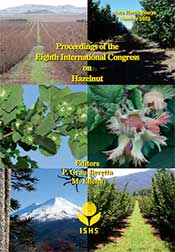Ver ítem
- xmlui.general.dspace_homeCentros e Institutos de InvestigaciónCIAP. Centro de Investigaciones AgropecuariasInstituto de Patología VegetalArtículos científicosxmlui.ArtifactBrowser.ItemViewer.trail
- Inicio
- Centros e Institutos de Investigación
- CIAP. Centro de Investigaciones Agropecuarias
- Instituto de Patología Vegetal
- Artículos científicos
- Ver ítem
Effect of solarization, organic matter, and Trichoderma on the severity of Verticillium wilt in olive trees (Olea europaea L.) and soil inoculum density
Resumen
In October 2005, two trials were conducted at two locations of La Rioja province (Argentina), to assess the effect of soil solarization, application of organic matter and inoculation with Thichoderma harziarum on diseased olive plants. The trials included 25 ‘Manzanilla’ and 12 ‘Arauco’ trees, with less than 50% of affected branches, at Aimogasta and El Tala. Treatments were: solarization (SOL), solarization + Trichoderma (SOL+TRI), solarization + organic
[ver mas...]
In October 2005, two trials were conducted at two locations of La Rioja province (Argentina), to assess the effect of soil solarization, application of organic matter and inoculation with Thichoderma harziarum on diseased olive plants. The trials included 25 ‘Manzanilla’ and 12 ‘Arauco’ trees, with less than 50% of affected branches, at Aimogasta and El Tala. Treatments were: solarization (SOL), solarization + Trichoderma (SOL+TRI), solarization + organic matter (SOL + OM) and control (C). Disease severities were recorded during 2.5 and 1.5 years, respectively. For soil solarization, a transparent polyethylene of 100 µm was placed around each tree for 3 months. Before placing the plastic and one year later, soil samples were taken to determine the initial amount of microsclerotia per gram of soil (ID). Solarized plots reached maximum 51°C and control plots 40°C. Initial ID values were 2.52 to 1.84 and 1.23 to 2.13 after one year. The major decreases were obtained for SOL+TRI (0.08) and SOL. Controls did not increase ID at El Tala but it decreased at Aimogasta. All treatments decreased disease severities but there were no differences among treatments. Overall, disease severities decreased from 19 to 8% and 34 to 5% at both places. There were significant differences among plants (replicates) within each treatment. Results may have been influenced by fungus pathogenecity, inoculum distribution and density, edaphic factors, soil solarization efficiency and natural recovery phenomenon.
[Cerrar]

Autor
Otero, Maria Laura;
Roca, Mónica;
Zapata, Raúl Lorenzo;
Ladux, Jose Luis;
Ortiz, J.;
Matias, Angel Cesar;
Perez, Beatriz Alida;
Descripción
VII International Symposium on Olive Growing, San Juan, Argentina
Fuente
Acta horticulturae 1057. (2014)
Fecha
2014
Editorial
International Society for Horticultural Science
Formato
pdf
Tipo de documento
artículo
Palabras Claves
Derechos de acceso
Restringido
 Excepto donde se diga explicitamente, este item se publica bajo la siguiente descripción: Creative Commons Attribution-NonCommercial-ShareAlike 2.5 Unported (CC BY-NC-SA 2.5)
Excepto donde se diga explicitamente, este item se publica bajo la siguiente descripción: Creative Commons Attribution-NonCommercial-ShareAlike 2.5 Unported (CC BY-NC-SA 2.5)

